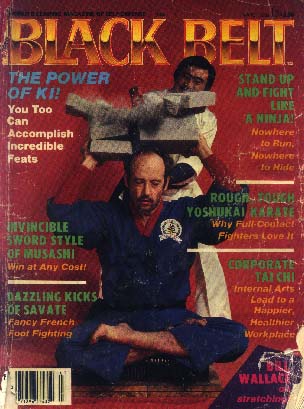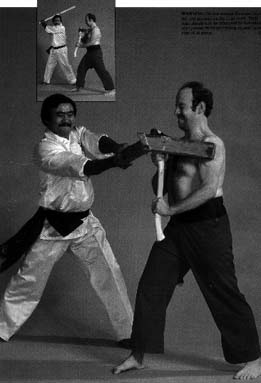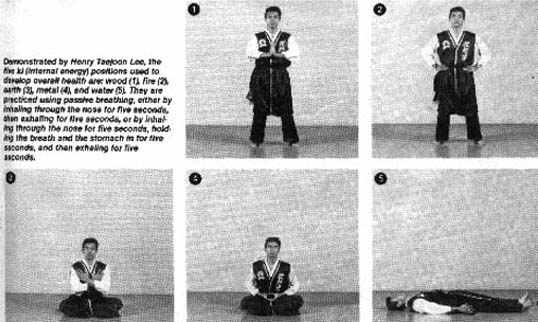

 In the martial arts,
the most mysterious and controversial subject is whether the phenomenon known as ki power
(internal energy) actually exists. Is the search for ki power a hopeless journey, much
like Ponce de Leon's fruitless quest for the "Fountain of Youth," or the
Cursaders' endless search fo the Holy Grail? Or, could it be that ki power has simply not
yet been discovered by mortal men?
In the martial arts,
the most mysterious and controversial subject is whether the phenomenon known as ki power
(internal energy) actually exists. Is the search for ki power a hopeless journey, much
like Ponce de Leon's fruitless quest for the "Fountain of Youth," or the
Cursaders' endless search fo the Holy Grail? Or, could it be that ki power has simply not
yet been discovered by mortal men?
The search for ki power might as well begin with the art of hwarang-do. In the following
interview with hwarang-do grandmaster Dr. Joo Bang Lee, one discovers the path attaining
maximum human potential. Lee, one of the foremost authorities on the development of ki
power, has dedicated his life to the propagation and advancement of the ancient Korean
martial and healing art of hwarang-do.
Black Belt: Is ki power fact or fiction?
Dr. Joo Bang Lee: Ki power is invisible and cannot be seen, and what we cannot see,
we usually do not believe. However, some of the most important things in our lives are
those which have no shape or form, but still exist as a major driving force. Ki exists in
all living things as it sustains life and maintains movement of matter.
BB: What exactly is ki, then?
Lee: At the beginning of the universe, there was nothingness, and in this
nothingness, there was ki-pure energy. As ki began to move, it developed two polar
dichotomies, um and yang. To every element, there is an equal opposing
element: um ki-invisibility, black, female, darkness, moon; and yang ki-visibility, white,
male, brightness, sun. As these opposing energies moved faster, it created noise, then
color. Ultimately, at its fastest speed, it created matter. The matter was divided into
five elements: wood, metal, fire, water, and earth. As ki moves and controls the elements
in the universe, so does it also control those in the human body. The human body is a
small microcosm of the universe and is governed by the same laws. Ki is the invisible
force which gives us the power for mobility and intellectuality. It is the life-force
which dwells in all human beings and all other living creatures on Earth.
BB: Does ki power work through faith or belief?
Lee: Not so much in the sense of religon, but belief is crucial in developing ki
power. The belief or confidence in one's physical ability is important in developing shin
ki (mental power), which is necessary in order to achieve a balance.
 BB: Are there different kinds of ki power?
BB: Are there different kinds of ki power?
Lee: Well, I guess you can call it different, but in essence it is really one which
serves to develop different aspects of our human potentials. There are three points in the
human body which generates ki power: sang dan jun - the point between the eyes
called in dang where shin ki is developed; joong dan jun - the point where jung
ki (physical ki power) is developed called dan joong; and ha dan jun,
where yuk ki is cultivated and divided into three points: ki hae (ki ocean),
kwan won (the best), and suk moon (stone gate).
BB: What is dan jun, and what is its importance?
Lee: Dan jun is often known as the "red field" which lies three inches
below the naval. Its importance lies in the fact that matter (yu) was created for
nothingness (moo). In order to understand the significance of this, we must go back
to the conception of human life. The egg (negative force) and the sperm (positive force)
are created by jung ki and unified into a single being which creates a new human being. It
is a fact that the egg always lodges itself at the same point every time, where it remains
until it is born as a human. This point is one of the points of dan jun. The first thing a
fertilized egg develops is an umbilical cord which attaches to the mother. Through this
umbilical cord, the fetus receives nutrients and energy from the mother for the next nine
months. This is how the baby receives ki from the mother. After nine months in the
mother's womb, the baby comes out to the external world and the first thing it does is
take in air. This clears out the baby's lungs and starts ki circulaion. The most important
thing in the universe is air, which develops ki internally in man. As we grow to be
adults, we all forget the importance of our belly button. The dan jun was the point in
which energy entered to give us life, and it maintains its importance as it continues to
be the umbilical cord to the universe. In order to have a healthy and strong body, one
must increase the level of ki through the utilization of the dan jun, which works as a
manufacturer of ki power.
BB: What would be the ideal state for the development of ki power, or what goal
should one try to realize?
Lee: The ultimate goal is to unify the three different dan jun as one, where all
three areas are equal. If we were to say that we all possess 100-percent potential ki
power, in our life span we only utilize 30-40 percent of it. However, some are born with
more ki power than others; an intelligent man might be physically weak, just as a
physically strong man might be mentally weak. Most people have an imbalance, and the goal
for every person should be to try to create a balance between the three points of ki
development: sang dan jun, joong dan jun, and ha dan jun. When one has attained this
level, we call it sam we il chae.
BB: How long does it take for one to acheive this level of ki power?
Lee: It is different for every person, but it usually takes three months to three
years.
BB: If that is so, there must be many people who have attained this advanced level
of ki power.
Lee: No, there are not that many who are at this level. One must follow a rigorous
plan of ki power development exercises. Attaining sam we il chae is only the
beginning; it is necessary for enhancing the intensity of ki power.
BB: When this level is attained, what are some of the things one is capable of?
Lee: This level is a means to realizing the maximum physical and mental potentials
of the individual. The things one can do are almost endless. Physically, one would be
three-to-five times stronger than normal, have better stamina and, mentally, one's level
of awareness and confidence will increase drastically.
BB: How does one know when one has acheived this level in training?
Lee: One should not expect to change physiologically, but one will change mentally
as well as physically. One will feel better, stronger, and healthier.
BB: In what ways can one know that he or she has progressed in ki level?
Lee: That is what demonstrations are for. It is an external, visible way to test
one's ki power.
BB: What kind of ki power "tests" can one perform?
Lee: After one has attained sam we il chae, one can test himself in the
following four areas: kyung ki (lightness)- being able to jump higher, land softer,
quickness and speed; jung ki (heaviness)- being heavy so that one cannot be picked
up or thrown; chul ki (hardness)- being able to make any part of the body hard as
steel; and ma ki (numbness)- being able to control pain so that one can perform
under great strain and gain extraordinary powers.
BB: How does one go about increasing one's level of ki power?
Lee: There are four different ways to increase one's level of ki power: dan jun
ho hup bop - breathing exercises; yak cha/yak ki - herbal medicine (hwarang-do
believes that if one has the ability to kill or maim, one should also know how to save and
cure); soo cha/soo ki - drinking water while one exercises breathing techniques;
and chul cha/chul ki - taking proper amounts of minerals.
 BB: What are some of the specific ki-developing
techniques one can practice?
BB: What are some of the specific ki-developing
techniques one can practice?
Lee: The most applicable and simple exercises are dan jun ho hup bop. These are
divided into two categories: um-jung (passive ki power development exercises), and yang-dong
(active ki power development exercises). There are five meditative positions in accordance
with the five elements in the universe-wood, steel, fire, water, earth. All of these
um-jung exercises must be done by concentrating on shin ki and breathing through the nose
deep into the lower dan jun and not so much into the lungs. While one is breathing, the
dan jun and the anus must be held tight. There are two ways to breathe: breathing in for
five seconds, holding for five seconds, and breathing out for five seconds; and breathing
in for five seconds and breathing out for five seconds. One can increase the time cycles
all the way up to ten seconds or more. These different positions help to develop the
correlating organs in the body. The difference between um ki power development and yang ki
power development is that in the latter, one must tighten the entire body from the
fingertips to the toes. There are many types of active ki power development: jung myun
bal ki - it develops jung ki (whole body), which will enhance ta ryuk (hitting
power); sa myun bal ki - it too develops jung ki, which promotes ta ryuk; sang
boo bal ki - it develops joong ki (heaviness); ha boo bal ki - it
develops kyung ki (lightness); pyung myun bal ki - this will help to develop
ma ki (numbness) to endure and control pain; and gi boo bal ki - this will
develop wrist strength and knife hands. There are also ki power exercises especially for kyuk
pa (breaking) techniques. The things to remember when practicing breaking are: the
easiest break is when one strikes the board or brick; and the most dangerous technique is pak
sul (breaking with the head).
BB: When is it best to practice these ki power development exercises?
Lee: When the sun is red; either sunrise or sunset.
BB: What feats have you accomplished through your ki power?
Lee: I have done numerous things, but let me first explain the different kinds of
ki power demonstrations: jung do - this is the "right way" or
"straight way" which is the demonstration of ki after proper training and time
for maturation; as sa sul, which are tricks for the eyes. These demonstrations
might seem impressive, but people who do not train properly will end up suffering
long-term injuries which will surface later in their lives. It is very important that one
first receives proper training in any aspect of ki power development before attempting to
perform any power demonstrations. I was the first one in the United States to cut five
watermelons on five people while blindfolded. I remember a time when a Japanese instructor
was trying to copy my demonstration and ended up cutting his student almost in half. Other
examples of sa sul are gluing broken boards and bricks together and breaking them over
again; breaking ice blocks which are stacked high with large spaces in between them,
making it almost as easy as breaking one block of ice; and breaking bottle necks which
have been slightly precut.
BB: Is this all there is to it? If one follows this path, will he or she attain the
desired level of ki power?
Lee: By no means is the quest for knowledge and betterment a finite endeavor. The
study of ki power is the most important aspect of martial arts training, and most
instructors today overlook it significance. However, I try to teach my students the
importance of ki power development for maintaining their health and realizing their
maximum human potential. If one desires to truly grow in this aspect of the martial arts,
then finding the right master is the "key."